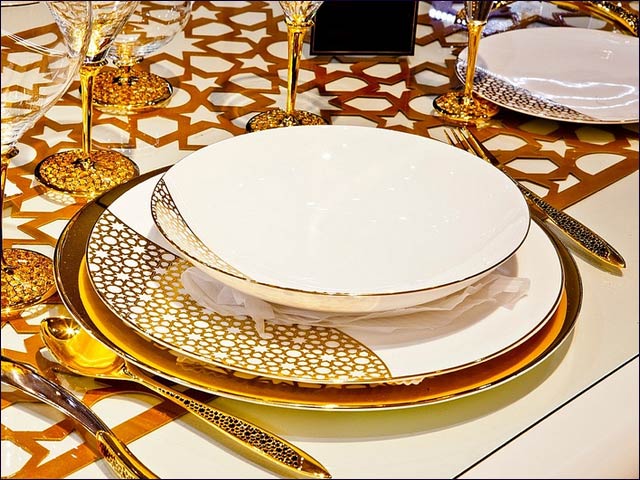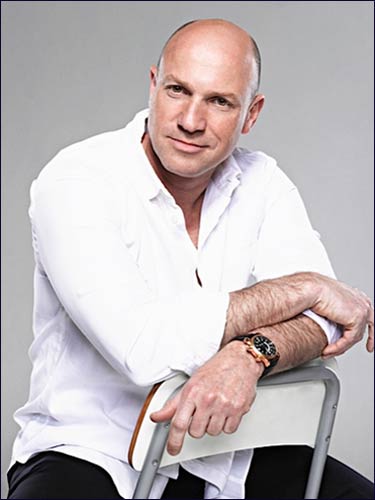By Avigayil Kadesh
The Louis Vuitton, Gucci and other high-end stores lining Tel Aviv’s tony Kikar Hamedina (State Square) have a new companion – the golden paradise of kabalistic designer Doron Merdinger.
The small shop was designed by its owner with the same sort of sophisticated imaging software he uses to envision his gold-enhanced heirloom table settings and gift items, jewelry and furniture.
"Traditionally, makers of high-end dinnerware have found it difficult to maintain the integrity and consistency of a single design throughout all the pieces of single-theme collections,” according to a 2008 article in Robb Report magazine. “The solution to this problem,” says Merdinger, “lies in the use of 3D computer imaging in the design process. Employing the technology yields greater consistency during the manufacturing phase."
Merdinger explains that he founded his business on insights gleaned from Jewish mysticism and advanced sciences such as quantum theory and game theory. “I tried to learn as much as I could about the universe, seeing the parallels between spiritual and physical approaches,” he says.
In 2005 he discovered new computer-assisted design (CAD) software, which held the key to realizing his dream to create a collection from the two-dimensional geometric grid of the classic arabesque shape -- an Islamic form of artistic decoration based on rhythmic linear patterns.
He points to the first result, a delicate sculpture called “Fallen Leaf” whose design is evident throughout his work.
“I was able to create it not in the ordinary way, from a real leaf or from a model of a real leaf, but with CAD technology to create the proper depth,” he says. “I felt with this arabesque grid I was able to explain to the computer how nature behaves. Then I took it forward to introduce the world’s first fully integrated tableware collection using these 3D files for production, and very advanced technologies such as laser cutting.”

A Merdinger place setting
His methodology was 180 degrees different than the typical design process, he says.
“Usually you learn to understand a certain material – porcelain, for example -- and how it will behave, and then you learn the technology. For me, I had to create tools to make a virtual image and then played with the colors and materials virtually so I could be very accurate. I am very confident that the material doesn’t matter. It is my privilege that I have always been able to create everything I saw in my head.”
Merely the channel
Merdinger considers himself a channel for this new methodology rather than its inventor. “I understand that this is my mission on earth,” he says. “I’m merely the one who found it, so I had to be very loyal to the origins of it. When I am designing, I try to focus on very small dots in the virtual space that you cannot see or feel or even understand with the mind.”
He did, however, come to his new design direction with a solid background managing the well-known Hazorfim silversmith chain that his father had founded after arriving in Israel in 1949 from Czernovitch, Romania. Doron was only 19 when his dad passed away. With the encouragement of his mother and older brother, after finishing his service in the IDF – where he worked in virtual three-dimensional spaces -- he went off to study business administration first in San Diego and then at New York University.
When he came home, he put in six years changing the total look and packaging of the family chain. Becoming general manager, he then began transitioning Hazorfim from a mostly Judaica business into a worldwide giftware company.

Doron Merdinger
“I redefined the core goal and set very high standards and directions, and then started introducing new items,” he says. “To materialize my own dreams and pursue my own goals I then decided to leave the company, during the same week the oldest of my three boys was born.”
Spiritual quest
Merdinger, born in 1968, says he was a nerdy kid who had one of the first personal computers in Israel and used to win a lot of drawing, sculpture and LEGO construction contests.
“I stayed home from school a lot because of my asthma, and my room was like a lab. I used to dismantle everything in the house, including the crystal chandelier.” In high school, he studied microelectronics and computers, and during his military service he dealt in 3D imaging.
He began studying kabala while at Hazorfim, in a quest to understand the universe from both a physical and spiritual perspective. He became obsessed with locating a copy of Sefer Yetzira (Book of Creation), the earliest extant book of Jewish mysticism, ascribed to the patriarch Abraham himself. It describes how God employed “32 wondrous ways of wisdom” to create the world, and delves into the deeper meanings of the 22 Hebrew letters; the 10 Sefirot that form the basis of kabala; the four basic elements; the planets and the Zodiac.
“I couldn’t find a copy anywhere, and then one day it was waiting for me at the entrance to my studio in Jaffa,” Merdinger relates. That studio, which he estimates to be about 3,500 years old, had an eight-pointed Star of Abraham design embedded in the floor.
One result of his reading this miraculously obtained book was making four silver ritual objects for the Temple Institute in Jerusalem. These are facsimiles of items found in the ancient Jewish Temples and meant to be put into use in a future third Temple. “I have a mission that when it will be built, I will be part of it,” he says.
Another result was his adoption of the Star of Abraham as his logo. This ancient design has been discovered in excavations in the Sumerian city of Ur, the birthplace of the patriarch Abraham. Merdinger explains that this symbol, in the three-dimensional sphere, evokes the divine chariot by way of its two pyramids, one pointing up and one pointing down, as well as the four elements of water, earth, wind and fire.
“I made huge discoveries about how the world was created, and I was able to connect it to mathematical approaches such as the zero-one, zero-one logical code,” says Merdinger. In other words, he figured out how to capture the ancient arabesque form in the binary language of computers.
Noble metals
Why did he switch to gold from silver when he opened his own design house?
“Silver and gold are both noble metals, so the shift wasn’t dramatic,” he explains. “Silver is a mirror while gold is more dominant, has more luster and doesn’t get a patina. There is something very spiritual for me about gold. According to kabalistic approaches, you are drawn to this metal. I felt gold is more fitting for this collection.”
He also employs precious stones, porcelain and crystal, using not only his modern tools but also classic metalworking equipment inherited from his father.
The hardest part of his work, he says, is amalgamating different materials -- porcelain with gold, glass with wood. “It is the same as in life – it’s very hard to make a unifying connection between man and woman. So the real secret is about combining and connecting materials, and this is where I found my passion. I especially like doing things people say cannot be done.”
Merdinger’s Arabesque collection is also sold at Thomas Goode in London, and through his own base of operations in Switzerland that allows him to deal directly with clients in the Arab world. And there are plenty of them: Pieces from the Arabesque tabletop collection have pride of place in Abu Dhabi’s deluxe Emirates Palace Hotel, in Dubai’s King Stores luxury shops and at a palace in Turkmenistan. Following a design lecture Merdinger gave in Calabria, Italy, he fielded inquiries from Iran and Syria.
The most inexpensive item in the store is a credit-card holder he made for Centurian American Express (about NIS 350/$ 97), while the most expensive single item is a gold-inlaid table, with a price tag of NIS 33,000 ($9,100). You can spend much more on sets of Merdinger creations, such as a $50,000 coffee set and a quarter-million-dollar dinnerware set. He also produces custom designs upon request.
One of his most dazzling items is a necklace he designed for pop star Madonna after he sat next to her at a kabalistic gathering in Israel in 2004. The silver and gold piece has 72 black diamonds, in the center of each is etched one of the three-letter mystical names of God, using atomic reactor technology. In the middle is her adopted Hebrew name, Esther.
“I didn’t give it to her,” he admits. “I was too shy. I don’t know if she knows about it.” He gave the piece to a Hazorfim assistant who was supposed to get it to Madonna, but he never heard from her.

Merdinger designed this 72-diamond necklace for Madonna,
but he’s not sure she received it
Married to a fitness instructor and living in the Tel Aviv suburb of Karmei Yosef, Merdinger sells his wares to art collectors and Russian oligarchs, princes and aristocrats from all over the world. He would like to open branded concept stores in every major city’s prime street, such as Madison Avenue in Manhattan, Petrovsky Boulevard in Moscow and Bond Street in London.
Though he is proud of his heritage and his homeland, Merdinger takes a more universal view of his craft and has produced a short video to illustrate it.
“I don’t present myself as a Jew or an Israeli,” says Merdinger. “My message to the world is that there is a God and he does not belong only to the Jews, the Christians or the Muslims. We need to understand that we need to share Him, not fight about Him. My creations are a symbol of the higher world since their morphology is unique -- they were created in the virtual reality, the higher world. They show there’s more to life than physical items.”